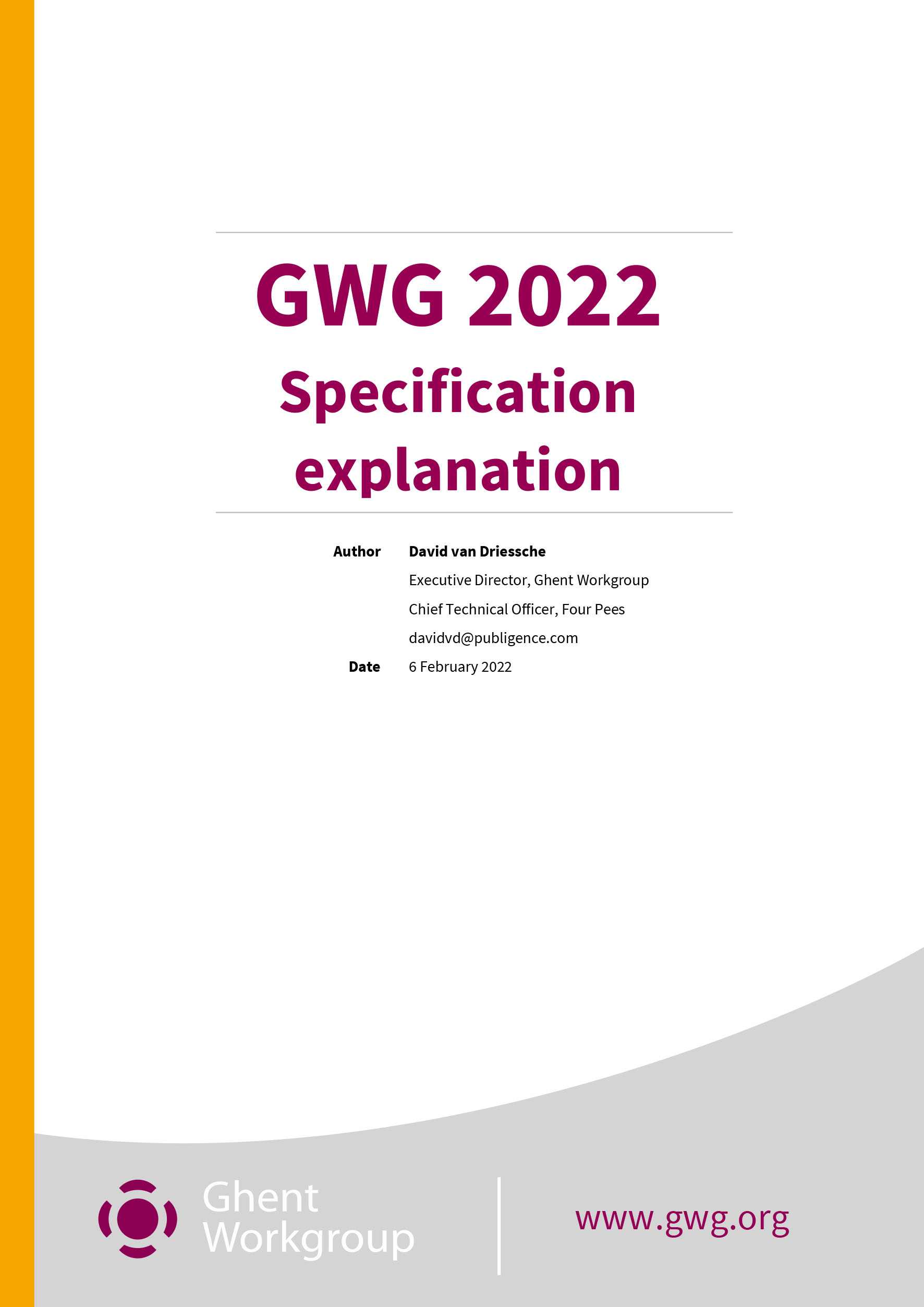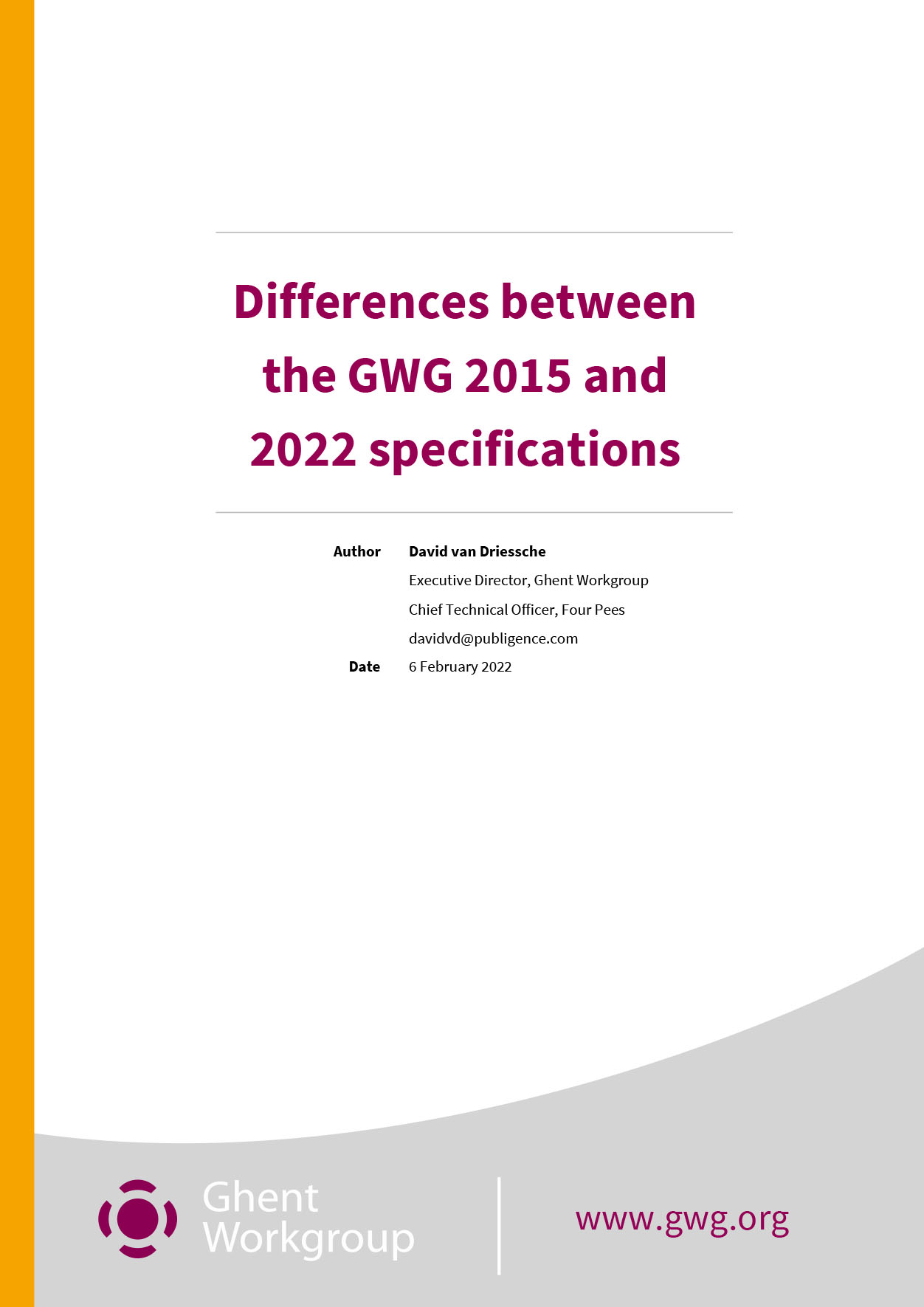Ghent Workgroup releases new specification: GWG 2022
GHENT, BELGIUM – 30 March 2022 – In a milestone release, the Ghent Workgroup (GWG) announces the completion and immediate availability of a new specification version called GWG 2022. The last major GWG specification was released in 2015. Since then, separate efforts took place for specific market segments such as Sign & Display, Digital Print and Packaging, but there was no real consolidation into the base specification. This made it more difficult to use the specification and more difficult for the Ghent Workgroup to evolve it. The GWG 2022 specification changes that by introducing new innovations on a new, streamlined, specification format.
“For printers, publishers and creatives, the most important question is what GWG 2022 can improve for them,” remarks David van Driessche, Executive Director of the Ghent Workgroup and CTO at Four Pees: “the major novelty in GWG 2022 that people will notice is the possibility to improve preflight results by cutting down false positives – preflight errors that are reported but really shouldn’t be because they would never cause production problems. For the application vendors working with GWG 2022, it is mostly the new specification format that makes their life easier”.
Cutting down on false positives
Over the last years, several vendors created technology designed to cut back on the number of false positives during preflight. You don’t want to stop a file because of an image if it is totally clipped away or covered by other page content for example. The GWG 2022 specification makes it possible for such technology to be used and defines the rules. This means that a preflight using GWG 2022 compliant profiles allows you to focus on those files that really would cause problems.
Processing Steps
In label and packaging workflows, a major new ISO standard (known as ISO 19593-1) was introduced that makes it possible to identify elements in a design needed for specific processing steps. The easiest example is perhaps that it provides a good way to identify cut and fold lines in a complex design. The GWG 2022 specification includes support for the Processing Steps standard and identifies which processing steps should and should not be present for different packaging products.
Streamlined specification format
Up to now, Ghent Workgroup specifications were released in a document that described all requirements and had tables for each variant to specify which requirements were used for each variant. As the specifications became more technical and more complex, this proved to be difficult to work with. GWG 2022 is released instead as a highly structured spreadsheet, which clearly defines definitions, requirements, and variants. The definitions and requirements have been rewritten in a more standardized and exact fashion and include unique IDs, version numbers and more to make it easier for software vendors to work with them.
More information
More information about this specification can of course be found on the GWG website (www.gwg.org). The Ghent Workgroup released two supporting documents about this specification:
Of course, the GWG 2022 specification spreadsheet is also freely available and can be found here.
The Ghent Workgroup, formed in June 2002, is an international assembly of industry associations, suppliers, educators and industry members from around the globe. The Ghent Workgroup’s objective is to establish and disseminate process specifications for best practices in graphic arts workflows.
Since its inception 20 years ago, the organization has consistently produced numerous process specifications for PDF exchange, as well as developing useful tools for automating processes and testing and establishing consistent PDFs for print, publishing and packaging production – all available free atwww.gwg.org.
Members are comprised of graphic arts associations including CIP4 (Switzerland), KVGO (the Netherlands), Febelgra (Belgium), Fespa (UK), Medibel+ (Belgium), PDFX-ready (Switzerland), Printing United Alliance (USA), and VIGC (Belgium). Vendor members include Agfa, callas software, Canon, DALIM Software, EFI, Enfocus, Esko, Global Graphics, Heidelberg, HYBRID Software, Kodak, PageProof, Ricoh, Tech Research (TagG) and Ultimate Technographics. Industry members are ArtOption, Four Pees, Igepa Sagamgraphic, JP/Politikens Hus, Litografia Rosés, Prinovis, RRD and ybam. Educational members are Arteveldehogeschool Gent, CEC LATAM, Future Schoolz India, Government Institute of Printing Technology (GIPT), Media University Stuttgart, Ryerson University, the University of Ljubljana, the University of Novi Sad, Universiti Teknologi MARA (UiTM), The Regional Institute of Printing Technology Kolkata and the University of Wuppertal.
All products and services are trademarks or registered trademarks of their respective owners and are hereby acknowledged.
Press contacts:
Ghent Workgroup
Christian Blaise
Carole Demeulemeester,



